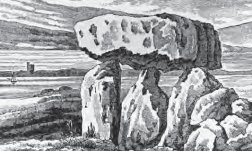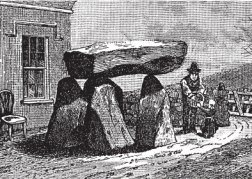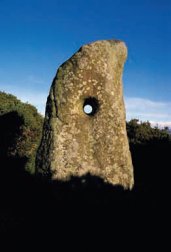


Ballylumford, County Antrim
Whereas some megalithic monuments are difficult to find, this neat 'Druid's Altar' could hardly be more conspicuous or accessible: it even has an address, 91 Ballylumford Road, Islandmagee, the result of an unlikely juxtaposition of a house of the living alongside a house of the dead.

When The Dublin Penny Journal published the accompanying woodcut in 1833, the tomb stood out as a solitary landmark at the relatively remote northern end of this peninsula. The present villa was built here later in the century and this 4000-year-old megalith became thoroughly domesticated, and is now a unique garden eye-catcher trimmed with flowers round the base.
 The dolmen is about 6 1/2 feet high overall and consists of a horizontal capstone 6 feet long and 18 inches thick, perched on a rectangular chamber of four stout uprights, all basalt. It may be a portal tomb, but could equally be the remains of a small passage tomb.
The dolmen is about 6 1/2 feet high overall and consists of a horizontal capstone 6 feet long and 18 inches thick, perched on a rectangular chamber of four stout uprights, all basalt. It may be a portal tomb, but could equally be the remains of a small passage tomb.
An early account states that it was formerly surrounded by a circle of standing stones, probably the revetment of a cairn, any trace of which has disappeared. A gold collar reportedly found here long ago is unlikely to have had any connection with the dolmen.
Doagh, County Antrim
 A well-known and adequately signed monument, this shapely Hole Stone crowns a steep-sided rocky knoll 1 1/2 miles north-west of the village of Doagh, to the east of a byroad leading north from the road to Kells. The outcrop on which it stands is heavily gorse-grown and the stone is only clearly visible from the top, which affords a 360° view of the surrounding countryside.
A well-known and adequately signed monument, this shapely Hole Stone crowns a steep-sided rocky knoll 1 1/2 miles north-west of the village of Doagh, to the east of a byroad leading north from the road to Kells. The outcrop on which it stands is heavily gorse-grown and the stone is only clearly visible from the top, which affords a 360° view of the surrounding countryside.The Hole Stone is a 5-feet high whinstone slab, 10 inches thick, tapering from a broad base to a blunt point offset to one side. It is pierced by a well-worn circular hole 3 1/2 inches in diameter, widening out countersunk fashion on each side, and evidently produced by artificial means.
It was formerly the custom for engaged couples to affirm their vows by clasping hands through this opening, whence its one-time sobriquet 'the love stone'.
The origin of the megalith is unknown, but it is possibly a relic of the Bronze Age and could have come from a destroyed tomb. In 1833 The Dublin Penny Journal printed a woodcut of the stone along with an account of troth-plighting commonly practised here; and Wood-Martin, writing in 1902, states that 'marriage contracts are still ratified at this spot as country couples go there to signify their betrothal clasping hands through the hole'.
It is noted that the aperture is too small to permit the average size man's hand to pass through, so presumably it was the prerogative of the bride-to-be to offer hers. A hole stone on the island of Cape Clear in Co. Cork bears a striking resemblance to the Doagh monument and is known as Cloch na nCealluna, 'the promising stone'. As a class hole stones are not particularly numerous, with only a few dozen examples recorded countrywide. Most are associated with long-standing folk customs of various kinds, often centred on healing and fertility rites, some of whose origins may date back to prehistoric times.
Click here to buy the Appletree Press book from Amazon.co.uk. For more information click on: Ireland's Ancient Stones - A Megalithic Heritage by Kenneth McNally, published by Appletree Press.
All Material © 1999-2008 irelandseye.com and contributors Privacy statement
